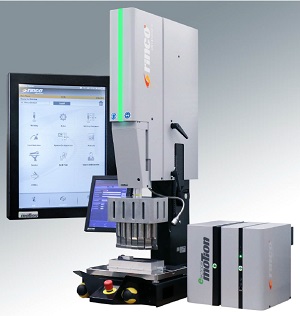Jun 25 2015
With its new Electrical Motion ultrasonic welding machine (working frequency: 20 kHz), the Swiss specialist for ultrasonic welding technology, Rinco Ultrasonics, is treading new ground: away from the traditional pneumatic drive to an electrically driven welding machine. With this solution, the relevant parameters for the joining process can be regulated individually and very finely – from the positioning of the sonotrode and the applied welding force to the welding rate.
 Equipped with an electric drive and a high-performance industry PC with touchscreen, the new
Electrical Motion ultrasonic welding machine can achieve excellent and reproducible weld
seam quality even with very difficult joining operations. Photo: Rinco Ultrasonics AG
Equipped with an electric drive and a high-performance industry PC with touchscreen, the new
Electrical Motion ultrasonic welding machine can achieve excellent and reproducible weld
seam quality even with very difficult joining operations. Photo: Rinco Ultrasonics AG
This is reflected above all in considerably better results, whether in welding, punching, cutting or sealing of moulded thermoplastic parts, nonwovens or synthetic textiles. Another innovation is that the welding machine is equipped with a high-performance industry type PC that can be comfortably operated via a 12-inch touchscreen. The welding process is triggered via an ergonomically designed twohand operation. The new Electrical Motion can be used for demanding joining operations in automotive construction, medical technology, packaging, textiles and the domestic appliance industry.
The Electrical Motion is a further development of the Dynamic 3000 ultrasonic welding machine (also with a working frequency of 20 kHz), which was designed especially for technically demanding welding operations for medium to large-sized thermoplastic parts. Unlike the compressed air-driven design, in which the feed for the sonotrode returns after every weld cycle to the starting position in the pneumatic cylinder, the starting position with the Electrical Motion can be freely selected. Consequently, the weld cycle can often be shortened, depending on the geometry of the object to be welded. The welding mode can also be freely selected. A total of eight modes are available for this: from time, distance and energy-related modes, to a combination of time and energy and a mode for presetting the melting rate. For all welding modes, the ultrasonic trigger can be adjusted as force, distance, time or as an external signal. The actual welding process can, depending on the welding mode, be subdivided into as many as ten steps. With this level of detail, the welding process can be controlled far more accurately than with a pneumatic drive. Even a speed-dependent or force-dependent weld profile can thus be achieved. All this results in a much improved weld quality so that even parts that were previously almost impossible or very difficult to weld can now be joined reliably using Electrical Motion with a reproducible and uniform weld seam. The converter, booster and sonotrode are identical in construction with the pneumatic Dynamic 3000 series, which means that moulds already made for this machine can also be used without modification on the new Electrical Motion.
The electrically driven ultrasonic welding machine is operated via the graphic user interface of the software, whereby an individual user account with the relevant authorisations can be set up for each level of the employee hierarchy. The robust, very stable Linux Ubuntu serves as the operating system. The specifically developed application software is logically structured, self-explanatory and easy to use. Weld characteristics are shown clearly in the form of graphs on the TFT monitor, and the results and parameter datasets can be exported on a data carrier. For documentation and tracking, all the results are saved in a database. All parameter changes and events (e.g. maintenance cycles) are recorded in the system and documented in the non-erasable audit trail. The relevant data are only accessible to authorised persons. To ensure high availability of the ultrasonic welding machine, the Electrical Motion can also be installed for remote access service. In the event of problems or malfunctions, a service technician from the Rinco headquarters can, with the help of remote maintenance via an Internet connection, quickly come up with a diagnosis and, in most cases, directly correct any parameter errors.